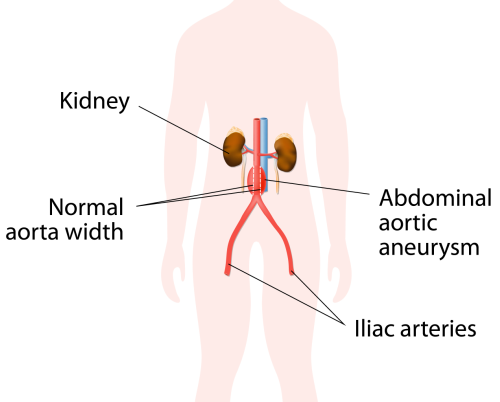Endoluminal Grafting for Abdominal Aortic Aneurysm Melbourne
A patient’s guide
What is an Abdominal Aortic Aneurysm
An aneurysm is an abnormal bulge or swelling in the wall of a blood vessel. It begins as a weak spot in the blood vessel wall, which then balloons out of shape over time by the force of the pumping blood.
Ageing and certain diseases can cause weakening of the aorta (the main artery from the heart to the lower body). As the aneurysm gets larger (known as abdominal aortic aneurysm) it becomes more likely that it will burst usually resulting in death.
It is usually recommended that aneurysms greater than 5cm be treated if the risk of rupture is greater than the risks of operating.
Depending on the patient’s suitability two treatment options may be available (1) Open surgical repair and (2) Endoluminal grafting.
1. Open Surgical Repair
The conventional operation involves a large abdominal incision. The diseased part of the aorta is replaced by a synthetic fabric tube (called the prosthesis or graft). The graft reduces the potential for rupture by protecting the weakened, enlarged area from rises in pressure in the blood flow, which could further stretch and weaken the aneurysm.
Recovery and risks
It is a major operation requiring deep general anaesthesia with 1–2 days in intensive care and then 7–14 days in a general hospital ward. The operation carries the risk of serious complications, including a 5–10% risk of death and morbidity (illness) rate of around 25–40%.
The risk of complication is greater in patients with severe lung, heart or kidney disease. Open surgical repair is a procedure that has been well tested over 40 years with excellent long-term results.
2. Endoluminal Grafting
The endoluminal grafting procedure usually involves inserting the graft by way of a small thin plastic tube (catheter), via an incision in one of the groin arteries.
The graft is guided into position using x-rays and ultrasound equipment, then expanded and secured in place to restore a more normal blood flow channel through the aorta.
It is a less major procedure requiring the same period of time in the operating theatre as open surgical repair, then 2–3 days in a general hospital ward, with no time spent in intensive care.
Risks
The overall risks of an endoluminal graft in suitable patients are different, and possibly less severe than those for open surgical repair at least in the short term. Available evidence suggests that mortality rates associated with the endoluminal repair of small aneurysms at the time of the operation are similar to those reported for open repair. Similarly, complication rates for endoluminal repair are comparable to those of conventional open repair.
Complications associated with the endoluminal procedure include:
- Blockage of arteries or veins
- Blood leaks from the upper or lower join of the graft to the artery
- Failure to place the graft.
If the graft cannot be placed, or if one of the major arteries is blocked, then open surgery would usually be required to correct these problems, usually during the same operation.
The endoluminal grafting procedure appears effective in the short term, and long term with follow up now for over 20 years. Ongoing surveillance is needed with endoluminal repair but general recovery and return to work is quicker than an open repair. If you are not suitable for endoluminal repair then open repair is still the gold standard procedure.
Endoluminal Grafting for Abdominal Aortic Aneurysm Melbourne
Mr Mark Lovelock consults and treats patients from all over Melbourne in relation to Endoluminal Grafting for Abdominal Aortic Aneurysm Procedures including Richmond, Mulgrave, Brighton, Box Hill, Wheelers Hill, Glen Waverley, Mount Waverley, Oakleigh, Gardenvale, Elsternwick, Elwood, St Kilda, St Kilda East, Caufield, Glen Huntly, Bentleigh, Hampton, Sandringham, Black Rock, Cremorne, Toorak, South Yarra, Collingwood, Fitzroy, South Melbourne, Hawthorn, Armadale, Surrey Hills, Blackburn, Burwood and Camberwell.




